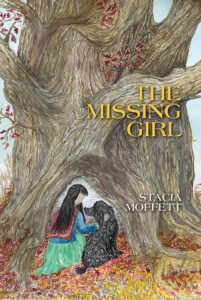Novelist Stacia Moffett is chatting with me today about her books in the Lost and Found in Tennessee series, Book 1: The Missing Girl, and Book 2: Jessa is Back.

Bio:
Stacia Moffett, author of the two-book series Lost and Found in Tennessee, which includes the titles The Missing Girl and Jessa is Back, was born into a family of educators in Nashville, Tennessee. Her father, an artist, but also a farmer at heart, moved the family to a small farm where Stacia and her brother, Carl, grew up surrounded by the natural beauty and challenges of rural life. This upbringing fostered her lifelong love for growing things and her affinity for dogs, books, music, art, and the warmth of her loving grandparents.
Moffett’s academic journey took her to Mississippi in the early 1960s, a time and place that deeply influenced her understanding of the South. She pursued graduate studies in the fascinating field of invertebrate behavior and neural control, which led her to work with a wide array of creatures, including millipedes, crabs, insects, and spiders. Accompanied by her husband, David, Stacia earned her Ph.D. at the University of Miami and completed postdoctoral training at Duke University. The couple eventually settled in Washington, where they both taught and conducted research at Washington State University while raising their three children: an immunologist, a vintner, and a poet.
Now retired, Moffett and her husband reside in a wild canyon of the Snake River, where they built their home, planted fruit trees and a garden, and established a commercial vineyard. With retirement came the call to write, which took Stacia back to her Southern roots. Through her writing, Stacia Moffett aims to share her experiences as a white girl in a bygone era, offering readers insights into the forces that continue to shape lives in the South. Her work captures the essence of a time gone by, inviting those who did not live through it to understand its enduring impact.
Welcome, Stacia. Please tell us about your current release.
Jessa, a 12-year-old white girl, runs away from the news that her parents and grandfather have been killed in a car crash. She and her dog hide out in a hollow tree on her grandfather’s farm and survive by scrounging produce from the farm. Meanwhile, the townspeople become paranoid about Jessa’s disappearance and arrest a Black mechanic in their attempt to deal with Jessa’s disappearance. This unsettles the uneasy truce between white and Black members of the town. The year is 1955 and the town’s Jim Crow attitudes are on display to Jessa’s relatives, who arrive when a snow storm threatens her self-sufficiency and forces her to come out of hiding and join these relatives to finish the school year in Portland, Oregon. Jessa’s friendship with a Black girl there leads her to oppose the attitudes and practices of her hometown when she returns the following summer. Through her persistence, the town’s school board is gradually persuaded to fund music education in the colored school, a mission Jessa undertook because it was her father’s dream. In the final analysis, Jessa learns from her own experience and that of others in the community that interracial friendships are essential for the people to come together and address the wrongs of the past.
What inspired you to write this book?
I like imagining scenarios that allow my characters to display an aptitude for self-sufficiency, so I gave Jessa that challenge. However, what convinced me to set the story in rural Tennessee in the 1950’s was my realization that the social norms I grew up with in the South were incomprehensible to my own children. Life in a college town in Washington State provided them with classmates of many nationalities. They could not believe the descriptions of separate water fountains and restrooms or the absolute separation of Blacks from whites in social situations. I found that I needed to paint a picture of how things were when I was growing up so that not only my own children could understand, but also to address social realities for a wider readership. Today, we are experiencing a resurgence of White Supremacy as a political force, along with the banning of books and limitation of voting rights and women’s rights. All this brings back for me the specter of Jim Crow. Many people, white people, like to look back at the 1950’s with rose-colored glasses and see a time when things were the way they “should be.” I put my memories of those times in these books to share my understanding that we have made some progress, not nearly enough, but the 1950’s were definitely not something we should ever want to go back to!
What exciting project are you working on next?
Most immediately is the outline of the third book in this series, which will be set in the early 1960’s, when Jessa and her Black girlfriend reunite to spend a summer together in Jessa’s hometown. It is the era of civil rights and I want to explore how the town’s people will respond to that challenge.
I am also writing a novel about my paternal grandmother and her transition from Roanoke, Virginia superintendent of education to farm wife and, eventually, the mother of eight children. This is a love story of the early twentieth century and calls for a lot of research that I am finding fascinating. Here is an excerpt from early in the story:
“What an exhilarating day! My students actually liked the story problems I made up for them – useful calculations for managing a household – papering the walls and purchasing cloth for sewing linens! Even little Kate was motivated to set up the equations.”
“That’s good, dear. Don’t get your hopes up, but the day might be even more exhilarating when you open that letter on the sideboard.”
Vivian looked around and jumped up to seize the letter. “It’s from the Board of Education!” She rushed to the desk and pulled out the pearl-handled letter-opener. Her hands trembled as she slit the back of the envelope. Adele and Aunt Mada watched expectantly as she began to read.
“Yes! So far, so good! It says I’m on the short list for School Superintendent! They want to meet with me and learn my views on how the system should be run.” She gave a little shake of her head in disbelief. “Listen to this: they want a five-year plan for the city’s schools. Oh, I love this!– I have a chance to tell them what an old maid schoolteacher thinks could be done with the city’s school system!
“Don’t you be talking about being an old maid, Vivian. – Some man may yet have the sense to recognize your value and make an offer.”
“Dear Aunt Mada, I gave up on marriage long ago. Men don’t like a woman who actually loves mathematics! Anyway, I don’t want to be beholden to any man! Men run everything.I’m so glad I dared to apply for the superintendent job. Now, at least, they will have to hear my plans before they pass me over!”
Like my mother, who wrote children’s books, I have a couple of books, one about marine turtles and another about animal friends that I am writing and plan to illustrate for our granddaughters.
When did you first consider yourself a writer?
I considered myself a writer – of letters – from my early high school years onward. In an era before electronic communication, I kept up an extensive correspondence by mail with family and friends, and after my marriage, that continued, especially in the letters that flew back and forth between my mother and myself. I pursued studies in biology and followed a path that led me away from writing as a career, but one reason I never really considered writing novels was that I was mystified by where plot came from. Only after I began writing the Jessa books did I discover that the characters pull the plot along almost faster than I could catch up! So, in answer to the question, I had had plenty of experience writing, but only after retirement did I discover the time and desire to call myself a writer.
Do you write full-time? If so, what’s your workday like? If not, what do you do other than write and how do you find time to write?
I definitely don’t write full-time. We have a farm, with goats, ducks, hens and our pet dogs, and orchards, two gardens, two greenhouses, and a commercial vineyard and winery that our son operates. This almost-self-sufficient lifestyle calls for gardening, picking, canning, and baking. Time for writing is stolen from housekeeping duties, with my husband’s blessing. We have surrounded ourselves with books and time for reading is just as important as time for writing, because it keeps me recharged.

What would you say is your interesting writing quirk?
When I am in the thick of creating a story, I take it with me everywhere – I am immersed in the book when I am preparing a meal, washing dogs, picking beans. It is so real to me that the reality around me fades by comparison.
As a child, what did you want to be when you grew up?
I took ballet lessons early, mainly because my mother never got that chance – but she could have been the dancer, not me, and so I gradually outgrew saying I would be a dancer. My love of nature was what grabbed me and determined my future, and it continues to underlie my writing. I am thankful that I was never pressured to be anything by my parents, and am glad that my husband and I were able to allow our own kids to choose their own destinies.
Anything additional you want to share with the readers?
The series, Lost and Found in Tennessee, is born out of the need to communicate. I have learned a lot over my lifetime that I want to share. Insights about what is important in life are included in these books, most principally the important opportunities for deep and lasting friendships. All too often, we get too busy or emphasize quantity over quality in our interpersonal lives, so this is a major message from my life to you.

Links:
Website | Amazon book 1 | Amazon book 2 | Facebook | LinkedIn
